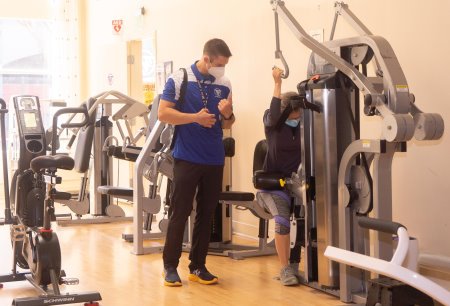
1. Because of the specificity of energy demands, varied muscle contraction dynamics and general body stress and fatigue, playing and practicing your sport should be a priority when it comes to physical preparation. As they did in the good ole days, you CAN play yourself into shape. It’s “sport-specific” and still true today. That stated, following a sensibly-designed conditioning program can further prepare one for the rigors of competition provided it “fits” with all strength training activities and practice sessions and does not over-stress the body’s recovery systems.
2. Like strength training, a legitimate conditioning activity must A.) create an overload on the (energy) system(s), B.) allow adequate recovery / adaptation time, C.) be progressive relative to the variables of running intensity, volume, distance and bout work / recovery times and D.) be performed on a regular basis.

3. All other factors being equal, running speed can be improved if one A.) gets stronger, B.) stays lean and C.) practices the skills of running fast.

4. Purported “speed drills” that do not replicate exact sprinting body mechanics (same speed, muscle contractions, angles of force output, etc.) may not transfer to improve speed. Again, the principle of specificity states that to become proficient in any activity, the activity itself must me practiced exactly. Anything “almost” or “close” is NOT exact. Therefore, general drills such as high knees, skips, bounds, box jumps, or other slower-moving actions (relative to all-out sprinting speed) can be used, but more as a part of a dynamic warm-up routine.
5. Being in good condition is also a part of a sound speed-enhancement program. Simply put, if you’re fatigued you cannot run at your maximum speed potential.

6. Straight-line sprinting ability does not correlate to lateral or backward agility or the ability to react and change directions based on game / contest situations.

7. All energy systems – ATP-PC (immediate), Lactic Acid (short term-high power) and Aerobic (long term-lower power) – are activated at the onset of any activity. What determines which system is relied upon the most is the intensity and length of the activity.

8. You don’t have to jog for 30-45 minutes or keep the heart rate in the “aerobic zone” to ultimately burn body fat. Shorter, higher intensity lactate threshold work actually gets you more bang for the buck, since it burns a lot of calories. Also, post-exercise fatty acid mobilization from the adipose (fat) tissue is accelerated after demanding, high intensity work.
9. One can improve lactate threshold and VO2 max with a variety of training regimens: short and long intervals, fartlek runs and continuous runs using various running speeds, distances, volumes and work-to-rest ratios.

10. Genetics also play a role in conditioning: those endowed with a high percentage of the slow / type 1 muscle fibers may possess better endurance and recover faster than those with more quicker-to-fatigue fast / type 2 fibers. On the other hand, predominantly fast/type 2 people may run relatively faster but take longer to recover between bouts, all other factors being equal.
TAKU’s Note: Way back in September 24, 2018 I put up a post called “Ten Things we know about Strength Training. I figured I was over due to add to that series. So check out todays post Ten Things We Know About Conditioning, and when you’re done, click the link and check out the first article in this series.
For assistance with creating Fun and Challenging conditioning circuits or for sport specific Strength and Conditioning or Personal Eating Plans for any goals, contact us here at TNT Strength.
TEXT “TNT” TO 855.796.9905 for more info
TNT has over 40 years of combined fitness experience, so if you’re looking for a coach who can train you in person in our Oakland California Studio or online from anywhere in the world, visit our online training page to book a consultation.

















